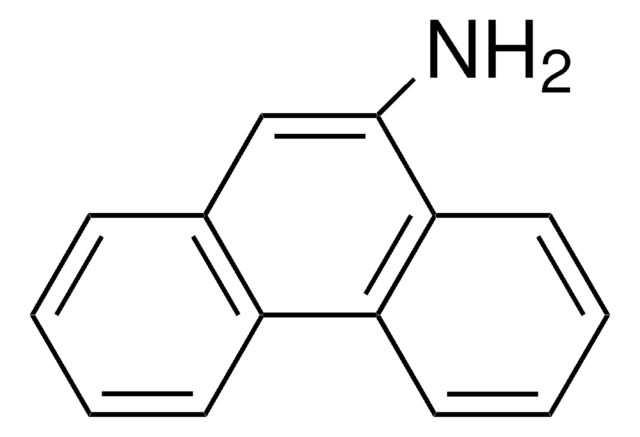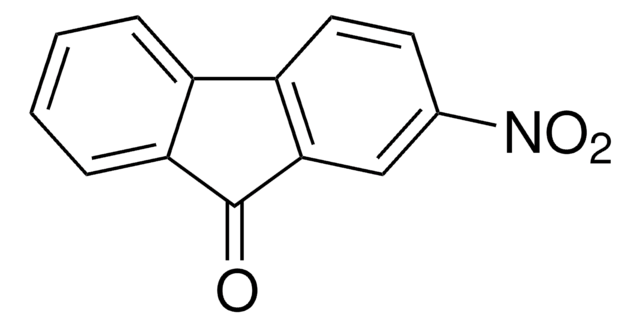A55500
2-Aminofluorene
98%
Synonym(s):
2-Fluorenamine, 2-Fluorenylamine
Sign Into View Organizational & Contract Pricing
All Photos(1)
About This Item
Empirical Formula (Hill Notation):
C13H11N
CAS Number:
Molecular Weight:
181.23
Beilstein:
1945861
EC Number:
MDL number:
UNSPSC Code:
12352100
PubChem Substance ID:
NACRES:
NA.22
Recommended Products
Quality Level
Assay
98%
form
powder
mp
124-128 °C (lit.)
SMILES string
Nc1ccc-2c(Cc3ccccc-23)c1
InChI
1S/C13H11N/c14-11-5-6-13-10(8-11)7-9-3-1-2-4-12(9)13/h1-6,8H,7,14H2
InChI key
CFRFHWQYWJMEJN-UHFFFAOYSA-N
Looking for similar products? Visit Product Comparison Guide
Related Categories
Signal Word
Warning
Hazard Statements
Precautionary Statements
Hazard Classifications
Aquatic Chronic 2 - Carc. 2
Storage Class Code
11 - Combustible Solids
WGK
WGK 3
Flash Point(F)
Not applicable
Flash Point(C)
Not applicable
Personal Protective Equipment
dust mask type N95 (US), Eyeshields, Gloves
Choose from one of the most recent versions:
Already Own This Product?
Find documentation for the products that you have recently purchased in the Document Library.
Customers Also Viewed
Prabhjit Kaur et al.
Food and chemical toxicology : an international journal published for the British Industrial Biological Research Association, 48(1), 320-325 (2009-10-27)
Rubia cordifolia L. (Rubiaceae) is an important medicinal plant used in the Ayurvedic medicinal system. Its use as a traditional therapeutic has been related to the treatment of skin disorders and cancer. Besides its medicinal value, anthraquinones from this plant
E Miadokova et al.
Phytotherapy research : PTR, 22(1), 77-81 (2007-08-29)
The extract of artichoke Cynara cardunculus L. (CCE) was investigated for its potential antigenotoxic and antioxidant effects using four experimental model systems. In the Saccharomyces cerevisiae mutagenicity/antimutagenicity assay, CCE significantly reduced the frequency of 4-nitroquinoline-N-oxide-induced revertants at the ilv1 locus
Silvia Di Giacomo et al.
Food and chemical toxicology : an international journal published for the British Industrial Biological Research Association, 111, 393-404 (2017-11-21)
In the present study, the ability of the natural sesquiterpene β-caryophyllene (CRY) and its metabolite β-caryophyllene oxide (CRYO) to inhibit the genotoxicity of a condensate of cigarette smoke (CSC) was evaluated both in bacterial and mammalian cells. Also, the inhibition
Vandana Gautam et al.
Saudi journal of biological sciences, 27(7), 1788-1796 (2020-06-23)
In the current investigation, the active principles of the methanol extracts of Rhododendron arboreum leaves (MEL) and flowers (MEF) were investigated with the help of ultra-high performance liquid chromatography (UHPLC), amino acid analyzer and gas chromatography mass spectrometry (GC-MS). UHPLC
Dominique Y Burnouf et al.
Journal of molecular biology, 386(4), 951-961 (2009-01-20)
The model carcinogen N-2-acetylaminofluorene covalently binds to the C8 position of guanine to form two adducts, the N-(2'-deoxyguanosine-8-yl)-aminofluorene (G-AF) and the N-2-(2'-deoxyguanosine-8-yl)-acetylaminofluorene (G-AAF). Although they are chemically closely related, their biological effects are strongly different and they are processed by
Our team of scientists has experience in all areas of research including Life Science, Material Science, Chemical Synthesis, Chromatography, Analytical and many others.
Contact Technical Service











